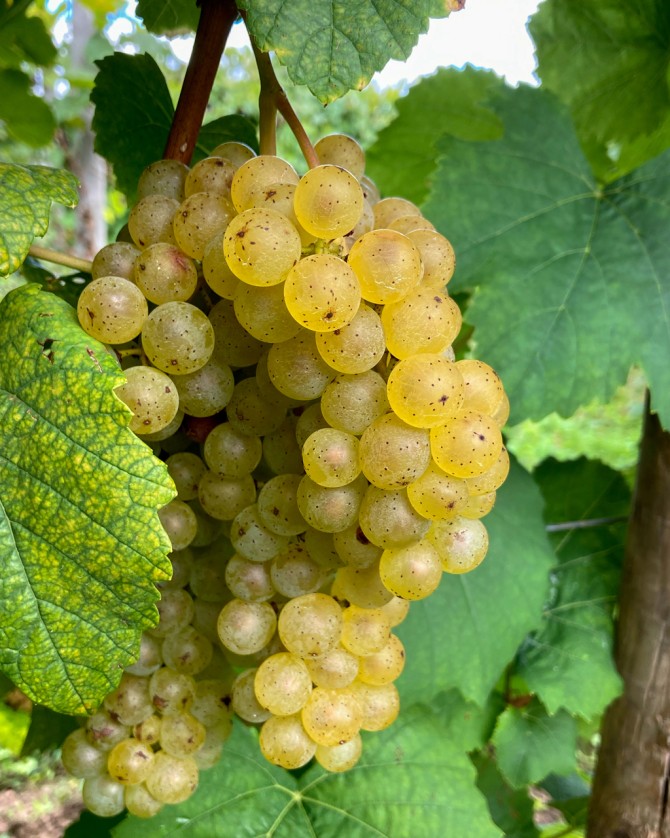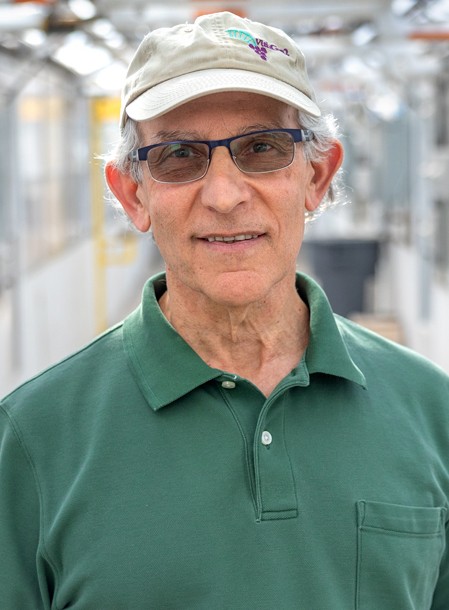New Cornell variety raises grape expectations for NYS wine
Introducing Aravelle – a new white wine grape that was 42 years in the making.
Renowned Cornell grape breeder Bruce Reisch made the hybrid by crossing Cayuga white and riesling grapes in 1981, at the start of his career. Now, 14 grape varieties later and with retirement looming this year, Reisch announced Aravelle’s release at the B.E.V. (Business, Enology and Viticulture) NY 2023 conference in Syracuse on March 28.
Aravelle contains traits of Cayuga white, a grape developed at Cornell in 1972, which is relatively resistant against bunch rot and mildew diseases, easy to grow, and very productive when it ripens in early to mid-September. The new variety combines those traits with the taste qualities of riesling grapes, which grow well in New York’s climate and are fairly winter hardy but have been quite susceptible to fruit rot during wet periods.
Among the 14 grape varieties released by Reisch’s program over the course of his career is traminette (1996), a white wine grape, which is now grown on hundreds of acres in New York and elsewhere, and accounts for between $40 and $60 million of wine produced annually. Overall, grapes developed at Cornell AgriTech, where Reisch is based, produce well over $100 million of wine a year.
The new variety has already generated interest in the industry and Reisch predicts sales will take off quickly.
“I anticipate that since we know so much about this grape and it’s been tested for such a long period of time, that it’ll do what’s expected,” said Reisch, professor in the School of Integrative Plant Science, Horticulture Section, and Plant Breeding and Genetics Section in the College of Agriculture and Life Sciences at Cornell AgriTech.
Compared to its riesling parent, Reisch expects the new grape could have slightly improved cold hardiness, much better rot and fungal disease resistance, and similar wine quality.
Breeding a new grape variety is a very detailed and rigorous process – typically taking more than 18 years for Reisch. After making the cross that would become Aravelle (initially dubbed ‘New York 81’) and providing stock for growers to test the vines, Reisch moved on to other projects.
“As we were beginning to lose interest in NY 81, growers came back to us and said, ‘This is much more rot resistant than riesling,’ so we began to look at that more closely,” Reisch said. Due to rot resistance transferred from Cayuga White, NY 81 didn’t have to be rushed to harvest as soon as a bit of rot appeared during wet harvest seasons.
“We proceeded with the testing and tried to optimize the parameters for winemaking and learning what type of yeast strains would make the best wine for everyone,” Reisch said.
Grape breeding requires multiple steps with many years of planting and testing to ensure proper quality and a grower’s trust in a variety. Crosses are made based on goals and objectives and what is known about the plants that breeders have developed.
Thousands of seedlings may be planted each year, with each one representing a potential new variety. These seedlings are tested for five to eight years, and the best are propagated to make six new vines having the desired traits. Three to four years later, they begin fruiting. So, some 12 to 15 years in, if those six vines look especially promising, breeders propagate them and send vines to nurseries.
In the case of NY 81, vines were sent to two partner New York nurseries, which shared test vines with interested vineyards.
“And they’ve said this really has commercial potential for them,” Reisch said.
Peter Weis, owner of Weis Vineyards in Hammondsport, New York, has used NY 81 as the sole grape in his “Heart of the Lake” generic white wine, which is produced in a semi-dry style and already has a strong following among his customers. Once he is able to plant more than the four acres currently growing, he would like to produce a dry style with the grape as well.
“What appeals most to me about NY 81 is its consistency from year to year, something that can be tough with other grapes grown in New York,” Weis said. “It’s consistent in terms of what it brings to a wine every year, and in the vineyard, it’s less prone to botrytis rot and powdery mildew, two diseases that New York wine makers really struggle with,” he added.
With encouragement from winemakers and growers, Reisch and colleagues worked with Cornell Cooperative Extension to produce enough fruit, and with Cornell enologists to optimize winemaking with the variety – a three-year process. And scientists and industry partners were polled on names, with Aravelle – from the Latin Arabella, which means “grace, favor, answer to prayers” – coming out the winner.
When Reisch began making the cross for NY 81, grape breeding may have been considered more of an art than a science. Over the last few decades, the use of genetic markers to identify desired traits has revolutionized plant breeding and made certain steps much more efficient, but it hasn’t sped up the process.
“We now have dense genetic marker maps of many different grape varieties,” Reisch said. The known markers allow breeders to plant thousands of seedlings and select only those that have desired genes, such as perfect flowers that will fruit on their own, and those that bring resistance against some of New York’s grape diseases.
Still, grape breeders currently don’t have markers to select for productivity or cold tolerance. Vines still need to be tested in multiple locations, for low temperature tolerance in the fall, winter and spring, adequate cluster and berry sizes and wine quality, among other traits.
“Growers want to know that a new variety has been tested in the field and really produces quality wine,” Reisch said.
Planting vines is a huge investment for growers, with hopes that they will yield fruits for 30 years after planting. A vine, for example, may tolerate New York’s cold climate, fluctuations in temperatures and flooding brought on by climate change, and they may resist the local diseases, but in the end, the fruits may not make good wine.
“Wine is a very complex creature,” Reisch said.
Due to moderate resistance to powdery and downy mildew and botrytis bunch rot, Aravelle can be grown with greatly reduced spraying of five or six well-timed treatments to prevent disease.
Aravelle could have been available as early as 2020, as Reisch and colleagues had wine samples ready for taste testing, but then the COVID-19 pandemic struck. “We certainly couldn’t have people unmasked in a room tasting wine,” Reisch said.
A few vineyards, such as Weis, which are already growing NY 81 vines, could produce a labelled Aravelle wine next year. New plantings at other vineyards will take three to four years and then another year to release to the market.
“What I would say about this release is how successful the older methods have been, that we could develop a grape like this that is in such demand in the year 2023, based on techniques in 1981, based on things that were done in the 50s, 60s and 70s,” he said.



